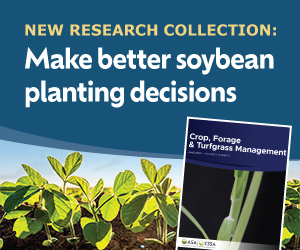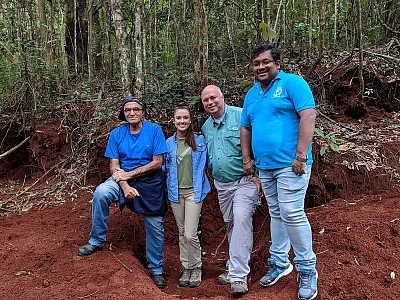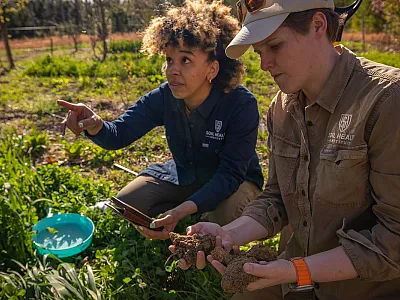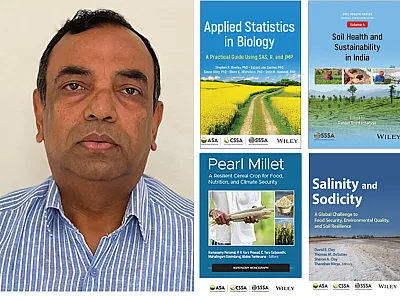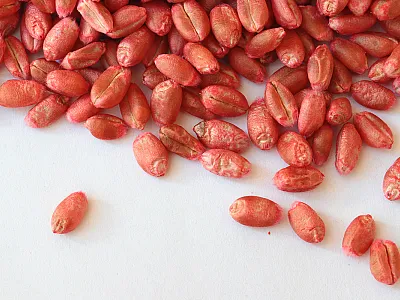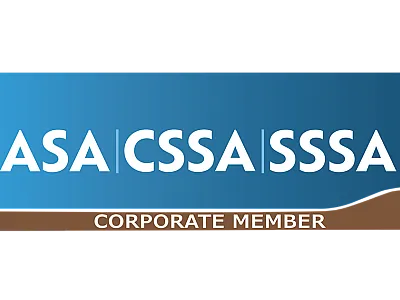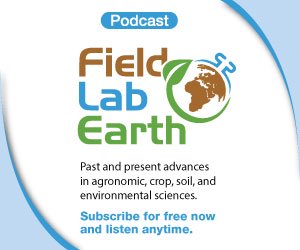Getting Support for Adoption of Climate-Smart 4R Practices
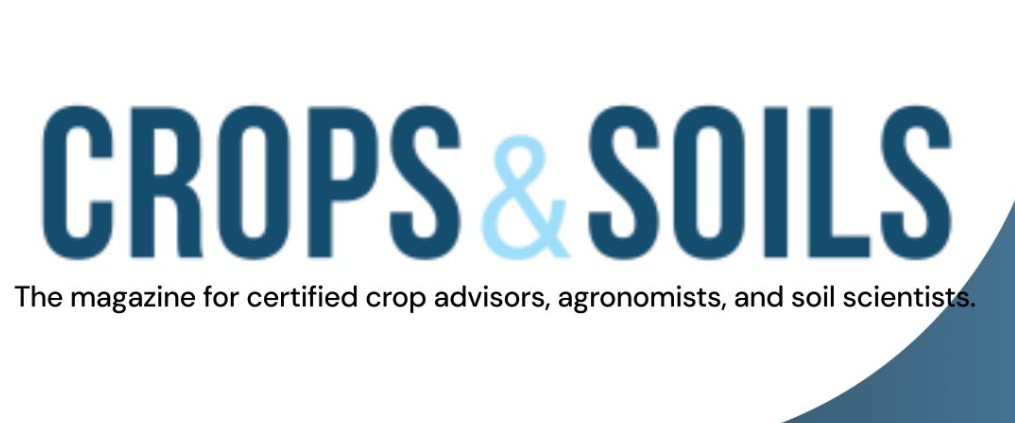
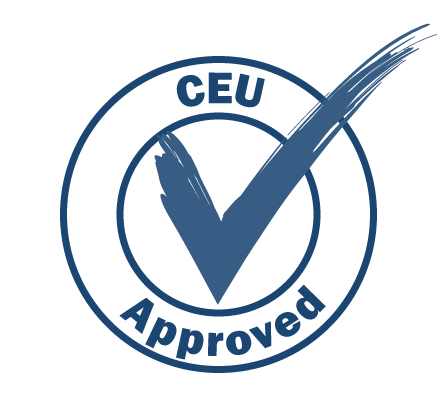
Nutrient management, particularly for nitrogen, plays an important role in improving the carbon footprint of crop production. Many programs have recently expanded their offerings or funding levels of incentives to farmers to adopt more climate-smart nutrient management practices. These programs provide opportunities for crop advisers to accelerate adoption among their clients of 4R practices that reduce greenhouse gas emissions and support soil carbon sequestration. The intent of this article is to provide a broad description of the programs available and the practices most likely to be effective. Earn 1.5 CEUs in Nutrient Management by reading this article and taking the quiz at https://web.sciencesocieties.org/Learning-Center/Courses.
Nutrient management, particularly for nitrogen, plays an important role in improving the carbon footprint of crop production. Many programs have recently expanded their offerings or funding levels of incentives to farmers to adopt more climate-smart nutrient management practices. These programs provide opportunities for crop advisers to accelerate adoption among their clients of 4R practices that reduce greenhouse gas (GHG) emissions and support soil carbon sequestration. The intent of this article is to provide a broad description of the programs available and the practices most likely to be effective.
Background
The agri-food sector emits a considerable proportion of the emissions driving climate change (Table 1). In the USA, the USEPA estimates the agricultural sector alone is responsible for roughly 10% of total emissions. While the mineral fertilizers applied to crops generate only a part of those emissions—around 2 to 3% in North America—there is nevertheless pressure on all sectors to move toward a “net-zero” future in which the amounts of heat-trapping gases in the atmosphere are stabilized (WRI, 2024). Despite the importance of fertilizers to food security, emissions arising from fertilizer use will not escape scrutiny.
Table 1. Greenhouse gas emissions (million tons CO2e) associated with the agri-food system in North America, 2016–2020.
| Agri-food systema | 1,386 |
|---|---|
| Farm gatea | 683 |
| Fertilizer manufacturea | 50 |
| Fertilizer useb | 129 |
| Cropland soil carbonb | -44 |
a Data from FAOSTAT, January 2024.
b Data from 2022 national greenhouse gas inventory reports, USA and Canada.
The emissions picture of the crop production sector differs from that of many others. Most other sectors focus simply on lower or zero emissions of carbon dioxide from energy use. The production of crops involves a complex interplay of three GHGs: nitrous oxide, methane, and carbon dioxide. Fertilizers, particularly those supplying nitrogen, can affect all three.
Three Key Greenhouse Gases
The most direct emission associated with nitrogen fertilizer is nitrous oxide (N2O). The amounts emitted are a small fraction of the nitrogen applied but comprise a big fraction of the carbon footprint of crop production. Each molecule of nitrous oxide traps as much heat as 273 molecules of carbon dioxide. A typical loss of 1% of the nitrogen in a 150 lb/ac application as nitrous oxide amounts to 644 lb of carbon-dioxide-equivalent (CO2e) emission per acre.
To add to the complexity, the amount of nitrous oxide lost is incredibly variable. Nitrous oxide is emitted from “hot spots” at “hot moments.” And the “hot” does not refer to temperature! It refers to the coincidence of conditions in the soil that drive emissions: a supply of nitrate, a supply of food (oxidizable carbon) for specific soil microbes, and soil moisture conditions that are “just right” for the oxygen supply to be partially depleted. The emission is a leak from two possible processes: nitrification of ammonia and denitrification of nitrate. Nitrous oxide emissions from nitrification occur when the soil is slightly less moist than the wetter conditions that favor those from the denitrification process.
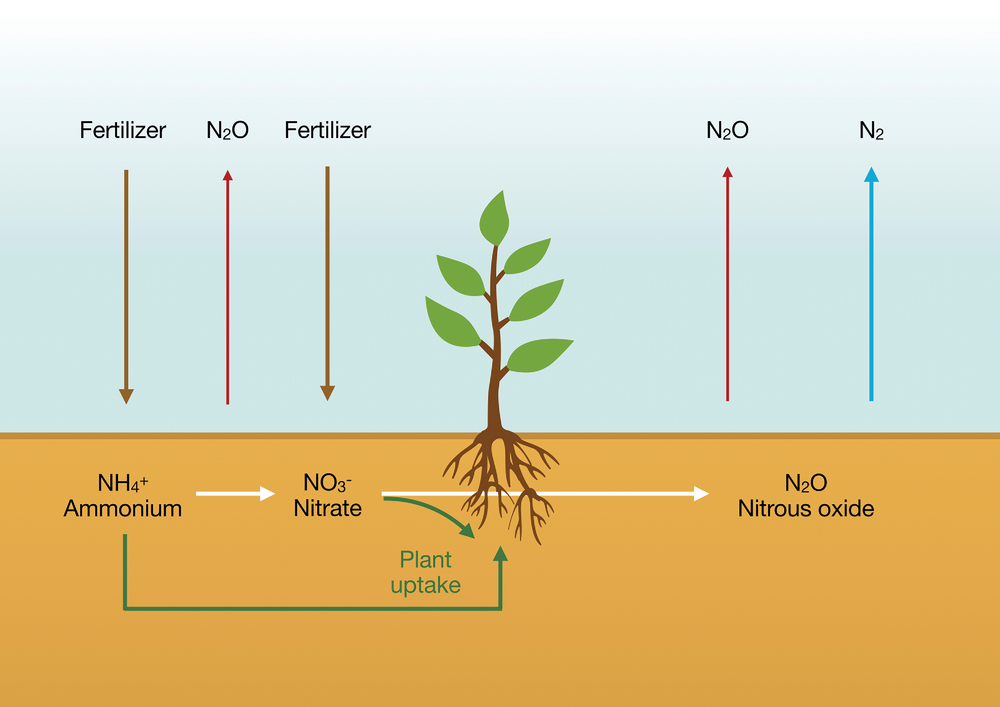
Direct emissions of nitrous oxide are complex enough, but we also need to consider the indirect. Surplus nitrogen can also be lost as ammonia to the air or nitrate to the water. A small fraction of the lost nitrogen is also emitted as nitrous oxide. It can’t really be measured, but it’s assumed to be at least as large a percentage as from nitrogen applied directly, roughly 1%. Other sources of nitrous oxide emission are from organic nitrogen in the soil and nitrogen in crop residues. Moving to include animals in the system, there are emissions from manure as well—both before and after it is applied to the soil. While nitrous oxide accounts for a small amount of the total N loss from cropping systems—compared with volatilization or leaching—its management remains important given its large impact as a GHG.
The complexity of nitrous oxide losses gives rise to many opportunities to reduce emission through management. But before we go there, we need to have a look at the other gases that are involved— perhaps less directly, but still involved and important.
The use of nitrogen fertilizer also affects emissions of carbon dioxide (CO2). When nitrogen increases plant growth, the crop takes up more carbon dioxide from the air through photosynthesis. Part of the enhanced uptake increases the harvested product, sparing land that would otherwise have been used to grow the same quantity of product. Another part of it increases the amount of crop residues and roots that contribute toward maintaining or enhancing organic carbon in the soil. These effects are hard to quantify in terms of net effect on GHG emission, but they can’t be neglected.
The use of nitrogen fertilizer can also affect methane (CH4) emissions. For most crops of North America, soils act as sinks, oxidizing methane. In some cases, use of ammonium forms of nitrogen can reduce those sinks, but the effect is small. Effects are larger for the carbon footprint of irrigated rice, in which methane emissions dominate the GHG contribution. Applying nitrogen fertilizer to rice can substantially increase methane loss.
Strategies to Reduce Emissions
Reducing emissions from nitrogen fertilizer can follow one or more nutrient stewardship strategies:
1. Use 4R practices to improve nitrogen use efficiency. This reduces the amount of fertilizer needed per unit of crop produced, reducing both emissions associated with manufacturing the fertilizer and those arising from its application.
2. Block nitrous oxide emissions by using 4R “right source” enhanced-efficiency fertilizers to slow the processes leading to nitrous oxide emission (Figure 1). These include inhibitors of nitrification and urease as well as controlled-release products.
3. Use additional management strategies to increase soil carbon sequestration. Surplus nitrogen can be bound up in soil organic matter, reducing potential for losses contributing to indirect emissions of nitrous oxide.
4. Some crops require unique strategies. In the case of rice, for example, use irrigation water management strategies that reduce methane emissions.

Support for Reducing Emissions
Options for support for climate-smart 4R practices are proliferating. Direct from government, the 2022 Inflation Reduction Act (IRA) in the USA and the On-Farm Climate Action Fund in Canada both offer cost-share funding for practices relevant to nitrogen management. The practices supported include nitrification inhibitors and the use of precision ag technologies. Commodity grain buyers and the sustainability programs of many private agribusiness companies and corporations may also reward the adoption of such practices.
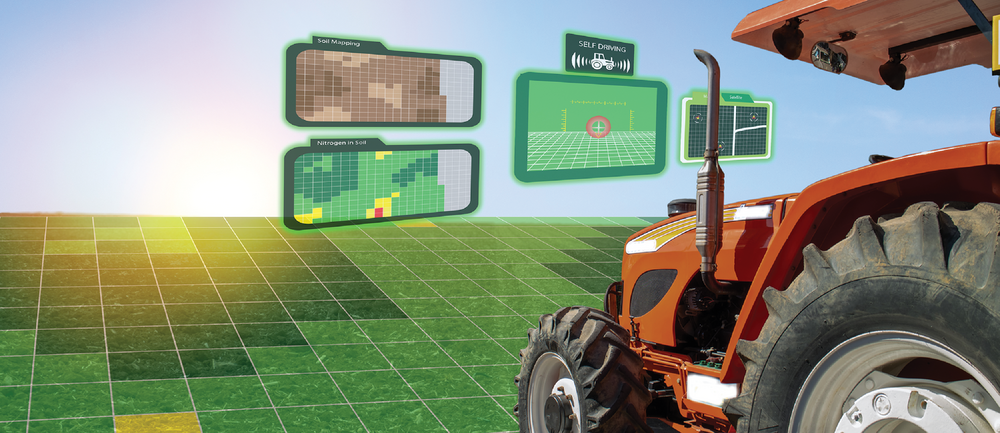
USA—2022 Inflation Reduction Act
Starting in 2023, the IRA has committed $19.5 billion in additional funding over the next five years to support the Natural Resources Conservation Service (NRCS) conservation programs that yield climate change mitigation benefits. Implementation began in 2023. These investments are designed to provide more producers with access to conservation assistance programs that in the past have been heavily oversubscribed.
These additional funds will help farmers, ranchers, and forest landowners implement expanded conservation practices that reduce GHG emissions and increase storage of carbon in their soil and trees. The conservation funding is in addition to otherwise available program funds, and participation is voluntary, incentive based, and targeted to support climate-smart mitigation activities and other conservation activities that facilitate them. The IRA funding does not change the current NRCS programs available for growers and consultants but expands the number of acres and growers the NRCS can serve with the programs. Regarding nutrient stewardship, it is primarily through conservation practice standard Nutrient Management (590) and associated enhancements.
Available NRCS conservation activities vary by state. To best evaluate the opportunities available in your county, contact your local or state NRCS office: https://offices.sc.egov.usda.gov/locator/app.
Environmental Quality Incentives Program (EQIP)
The Environmental Quality Incentives Program (EQIP) is NRCS’ flagship conservation program that helps farmers, ranchers, and forest landowners integrate conservation into working lands to address natural resource concerns. The nutrient management plans funded with EQIP offer opportunities for more intensive nutrient management (such as precision agriculture) to increase efficiency and reduce site-specific risk of nutrient loss.
Conservation Stewardship Program (CSP)
The enhancements available within CSP are intended to benefit producers who have already addressed their main resource concerns. Currently, there are four specific nutrient management (practice code 590) enhancements: E590A, E590B, E590C, and E590D. They are described further below and are considered climate smart and eligible for IRA funding.
Regional Conservation Partnership Program (RCPP)
The IRA is providing enhanced funding across 81 projects through the RCPP, which takes a voluntary approach to expand the reach of conservation efforts and climate-smart agriculture through public– private partnerships. Projects led by the Sand County Foundation, the Kansas Department of Agriculture, the Nature Conservancy, and Growmark, Inc. support reduced nutrient loss and GHG emissions. Some use the same practice definitions and GHG quantification as NRCS. For the full project list, see the RCPP 2023 Awarded Projects: https://bit.ly/49lzGHE.
The NRCS payment scenarios available for each practice in each of the above three programs in each state are provided at nrcs.usda.gov/getting-assistance/payment-schedules.
Partnerships for Climate-Smart Commodities
The USDA has also invested in 141 projects through this effort that seeks to expand markets for America’s climate-smart commodities. The project dashboard (https://bit.ly/4bwJ2lK) enables users to find projects supporting specific practices and enhancements. For example, nutrient management enhancements E590A and/or E590B are supported in four projects, led by Field to Market, Re-Nuble, Inc., the University of Texas at Arlington, and USA Rice Federation, Inc. Many more projects provide support for general nutrient management (590) practices, including certified nutrient management planning, soil testing, and plant analysis.
USDA-NRCS Conservation Practice Standard
The agriculture community has worked with NRCS for several decades to implement the conservation practice standard Nutrient Management (590). Practices other than 590 may also involve nutrient management. For example, cover cropping (340) involves rate reduction for nitrogen—50% for legume and 25% for non-legume—and results in small reductions in both direct and indirect nitrous oxide emissions as well as a credit for enhancing soil carbon (as estimated by the COMET-planner tool).
Four enhancements of nutrient management are available in CSP:
i. E590A—Improving nutrient uptake efficiency and reducing risk of nutrient losses. It includes use of nitrification inhibitors, urease inhibitors, and biostimulants.
ii. E590B—Reduce risks of nutrient loss to surface water by utilizing precision agriculture technologies.
iii. E590C—Improving nutrient uptake efficiency and reducing risk of nutrient losses on pasture.
iv. E590D—Reduce risks of nutrient losses to surface and groundwater by increasing setback awareness via precision technology.
The E590A enhancement is likely the most promising candidate for substantial reductions of nitrous oxide emission. It offers a flexible choice of two or more strategies from a list of 10. The list includes known nitrification inhibitors, urease inhibitors, and controlled-release fertilizers as defined by the Association of American Plant Food Control Officials, but also includes modifications to fertilizer application timing and placement. Recent meta-analyses have documented emission reductions as large as 15 to 50% in field studies on several of these practices (Thapa et al., 2016; Grados et al.,2022), even though their effects on crop yields and nitrogen use efficiency are considerably smaller (Young et al., 2021). This enhancement also includes nature-based fertilizers, biostimulants, and biofertilizers as well, but the evidence base for their efficacy is not yet well developed.
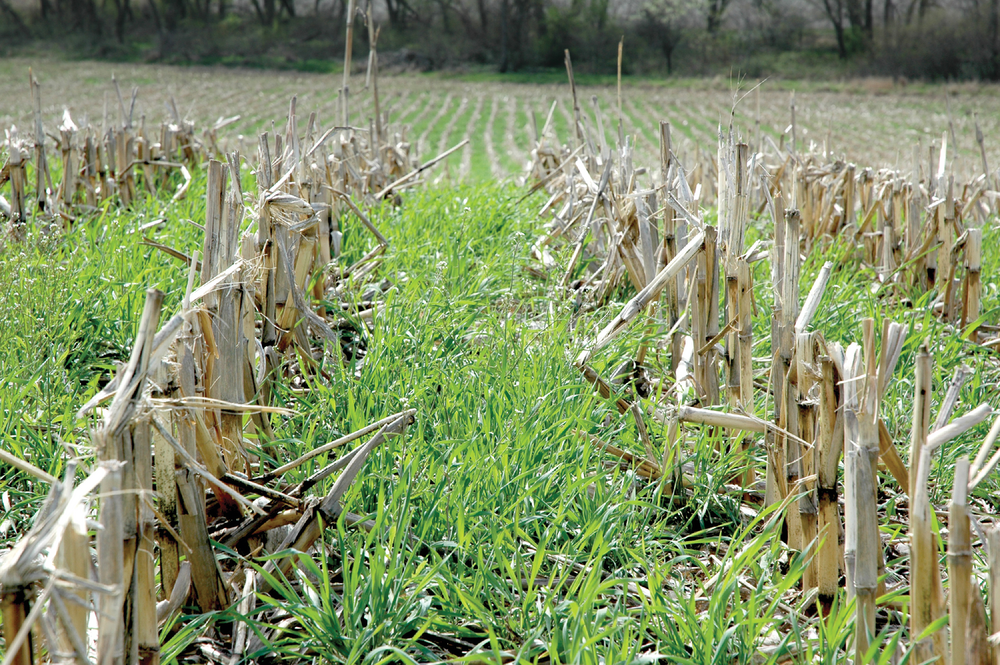
The E590B enhancement offers a great way to get into precision technology. It requires use of variable-rate technology for nutrient application. Fields are mapped and divided into at least three management zones based on productivity. The variable-rate technology may be based on maps or sensors or be manual. If nitrogen use efficiency is improved, both economic and environmental benefits can be expected. Nitrous oxide emission reduction would likely be quantified in terms of the reduction in use of nitrogen fertilizer per unit of crop yield in relation to past practices. In addition to nutrient benefits, the management zone approach also can support other agronomic practices, such as optimizing seeding densities across fields, offering growers another bonus for this conservation program.
The E590C enhancement recognizes practices that reduce nutrient losses (emissions) from pastures. It offers a flexible choice of two or more strategies from a list of five. The list includes split application of nitrogen, nutrient placement below the soil surface (with minimal soil disturbance), using variable-rate technology as for E590B, moving feeding locations to distribute manure nutrients more evenly across the field, and soil pH management through liming. Use of inhibitors (dicyandiamide—DCD; 3,4-dimethylpyrazole phosphate—DMPP; and nitrapyrin) is absent from this list, despite considerable evidence of efficacy for reducing nitrous oxide emissions across a range of N sources (urine, dung, slurry, and fertilizer) and inhibitor products (Soares et al., 2023). Concerns about the presence of these inhibitors in foods, particularly milk, limit their use on grazed pastures. Further research is yet required to clarify effects on animal and human health and establish a Maximum Residue Limit for these compounds in the Codex Alimentarius international food standards (Manaaki Whenua, 2019). The E590D enhancement uses precision technology to document and geolocate all setbacks, ensuring compliance with any rate restrictions for nutrient application in areas sensitive to contamination of surface or ground waters. They include, but are not limited to, state-specific nutrient application surface/groundwater setbacks and sensitive areas including soils and bedrock restrictions.
Canada
The Canadian federal government introduced the Agricultural Climate Solutions—On-Farm Climate Action Fund (OFCAF) for the 2022 and 2023 crop seasons, initially with $200 million in funding. Canada’s 2022 and 2023 federal budgets added another $504 million to extend the program to 2028. The OFCAF program enables regional partner organizations to offer cost share for adoption of practices to mitigate GHG emissions.
The partner organizations include:
- ALUS Canada
- BC Investment Agriculture Foundation
- Canadian Forage and Grassland Association
- Canola Council of Canada
- ECOCERT Canada
- Manitoba Association of Watersheds
- Manitoba Métis Federation
- New Brunswick Soil and Crop Improvement Association
- Ontario Soil and Crop Improvement Association
- Perennia Food and Agriculture Inc.
- Prince Edward Island Federation of Agriculture
- Results Driven Agriculture Research (RDAR)
- L’Union des producteurs agricoles (UPA)
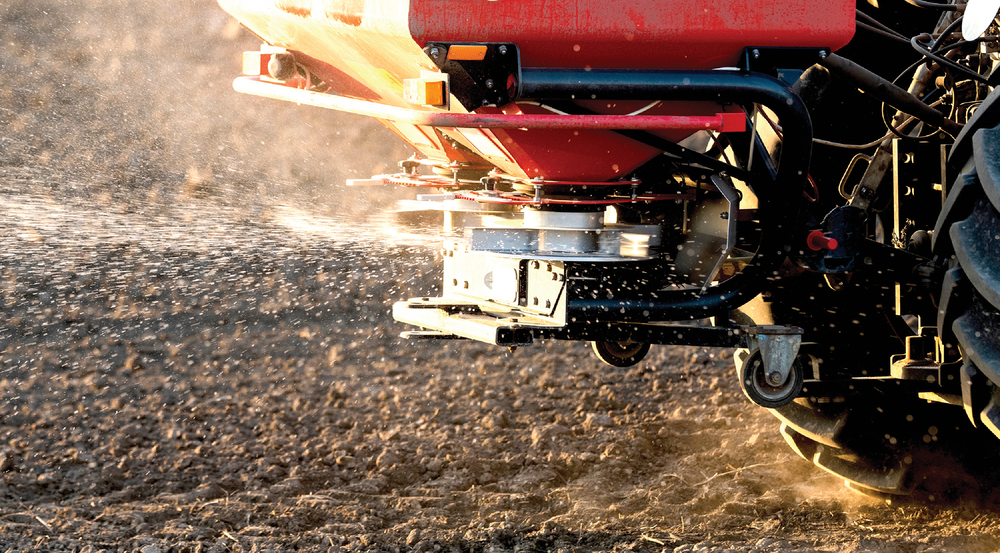
The aspirational adoption rates for the supported management practices are expected to achieve an annual emission reduction of 3.5 million tons of CO2e by 2030. More than 70% of this expected reduction in GHG emissions is attributed to an anticipated increase in adoption of enhanced- efficiency fertilizers, specifically fertilizers containing nitrification and urease inhibitors or using controlled-release coatings to reduce losses of nitrous oxide and ammonia. The remaining reduction in emissions is expected from two additional practices. First, the increased use of split application and sidedress application of nitrogen is expected to synchronize nutrient supply with plant demand and thus reduce nitrogen losses. Second, the increased use of legumes in rotation is expected to slightly reduce use of nitrogen fertilizer.
Quantification
Currently, neither Canada nor the United States recognize the influence of 4R nitrogen management practices (other than rates of application) in the national GHG inventory reports they submit annually in accordance with the UN Framework Convention on Climate Change. Efforts are underway, however, to do so at some time in the future as part of each country’s commitments to reduce emissions.
Many of the NRCS practices are associated with specific emission reductions, estimated using the COMET-Planner evaluation tool, available online at http://comet-planner.com/. As of December 2023, COMET-Planner provides carbon sequestration and nitrous oxide emission reduction estimates for many NRCS practices but numbers specific to nutrient management (590) enhancement scenarios are not yet provided. NRCS continues to evaluate additional practices and enhancements as science progresses, including quantification methodologies.
The Inflation Reduction Act of 2022 also invests $300 million over eight years to collect field-based data and use that data to improve models and outcome estimates for conservation programs and the national inventory. This work supports the broader USDA’s measurement, monitoring, reporting, and verification (MMRV) portfolio. These funds are intended to support a comprehensive strategy to improve data, models, and tools needed for quantifying the impact of conservation practices on GHG emissions and carbon sequestration.
Concluding Thoughts
The programs described above are expected to achieve only a first step toward net zero. If successful, by 2030 they could reduce current emissions associated with fertilizer use by 30%. What will it take to go further and achieve “net zero” for plant nutrition by 2050? Going beyond the practices described above will require a massive on-farm research initiative. Lasting improvement in nitrogen use efficiency requires more dynamic approaches to predicting optimum rates because weather drives large variation. Decision tools such as Adapt-N, developed by Cornell University and marketed by Yara, consider more factors than those included in most land grant university recommendations, but require yet more on-farm research for validation.
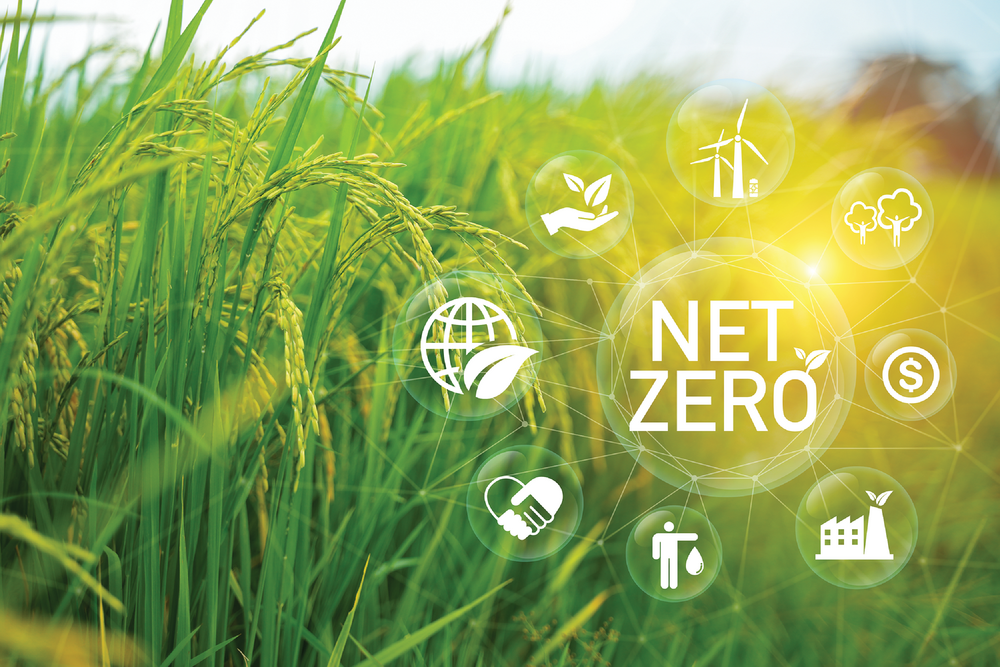
Innovative technologies for nitrous oxide measurement exist. Such technologies could be mobilized for both small- and field-scale research to validate models that make credible estimates of the reduced emissions from innovative 4R practices. For example, new LI-COR dynamic chambers allow automated sampling and a measurement of emissions every two minutes. Thousands and thousands of measurements are being collected to inform modeling efforts—the development, calibration, and validation of models predicting effects of the interactions of management with the dynamic conditions in the soil (Boehl, 2023).
The fertilizer sector is setting high ambitions for emissions reduction (IFA, 2022) similar to what the dairy sector is doing with its Net Zero Initiative (Afshar, 2023). Much of the drive to reduce emissions comes from the consumer, whose expectations for sustainably produced food are rising. Consumer-driven expectations can be transformed into opportunities to monetize emission reduction benefits.
Since the fertilizer industry is less connected to the food consumer than the dairy industry, it makes sense to collaborate and partner with other agricultural and commodity organizations in supporting programs and research aimed at reducing carbon footprints. Achieving more sustainable plant nutrition will depend on industry investment in innovative on-farm research in partnership with the larger agri-food value chain and in collaboration with universities and government agencies. In the meantime, the opportunities to take the first steps should not be missed!
References
Afshar, R. (2023). The race to reduce greenhouse gas emissions in U.S. dairy through improved soil health. Crops & Soils 56(4), 14–17. https://doi.org/10.1002/crso.20294
Boehl, J.V.M. (2023). Measuring greenhouse gases in dairy soils: innovative technologies to advance in-the-field research. Crops & Soils, 56(6), 4–9. https://doi.org/10.1002/crso.20319
Grados, D., Butterbach-Bahl, K., Chen, J., Jan van Groenigen, K., Olesen, J.E., Willem van Groenigen, J., & Abalos, D. (2022). Synthesizing the evidence of nitrous oxide mitigation practices in agroecosystems. Environmental Research Letters. doi: 10.1088/1748-9326/AC9B50.
IFA. (2022). Reducing emissions from fertilizer use. International Fertilizer Association and SystemIQ. https://www.fertilizer.org/resource/reducing-emissions-from-fertilizer-use-report/
Manaaki Whenua Landcare Research. (2019). A review of the potential of nitrification inhibitors DMPP and nitrapyrin to reduce N2O emissions following urine deposition in grazed pastures. New Zealand Agricultural Greenhouse Gas Research Centre. https://bit.ly/3SOkbme
Soares, J.R., Souza, B.R., Mazzetto, A.M., Galdos, M.V., Chadwick, D.R., Campbell, E.E., ... & Lynd, L.R. (2023). Mitigation of nitrous oxide emissions in grazing systems through nitrification inhibitors: a meta-analysis. Nutrient Cycling in Agroecosystems, 125(3), 359–377. doi: 10.1007/s10705-022-10256-8
Thapa, R., Chatterjee, A., Awale, R., McGranahan, D.A., & Daigh, A. (2016). Effect of enhanced efficiency fertilizers on nitrous oxide emissions and crop yields: a meta-analysis. Soil Science Society of America Journal, 80(5), 1121–1134. https://doi.org/10.2136/sssaj2016.06.0179
WRI. (2024). What does "net-zero emissions" mean? World Resources Institute. https://www.wri.org/insights/net-zero-ghg-emissions-questions-answered
Young, M.D., Ros, G.H., & de Vries, W. (2021). Impacts of agronomic measures on crop, soil, and environmental indicators: A review and synthesis of meta-analysis. Agriculture, Ecosystems & Environment, 319, 107551. https://doi.org/10.1016/j.agee.2021.107551
Self-Study CEU Quiz
Earn 1.5 CEUs in Nutrient Management by taking the quiz for the article at https://web.sciencesocieties.org/Learning-Center/Courses. For your convenience, the quiz is printed below. The CEU can be purchased individually, or you can access as part of your Online Classroom Subscription.
- The greenhouse gas emissions associated with fertilizers as a percentage of total greenhouse gas emissions in North America amount to
- less than 2%.
- 2 to 3%.
- 10%.
- 70%.
- According to the USEPA, what percentage of total emissions in the USA does the agricultural sector contribute?
- 5%.
- 10%.
- 15%.
- 20%.
- Greenhouse gas emissions associated with fertilizer include
- nitrous oxide only.
- nitrous oxide and methane.
- nitrous oxide and carbon dioxide.
- nitrous oxide, methane, and carbon dioxide.
- Which soil microbes are inhibited by nitrification inhibitors?
- Methylobacterium.
- Nitrobacter.
- Nitrosomonas.
- Gluconacetobacter.
- Critical factors governing the loss of nitrous oxide from the soil after fertilizer application include
- soil moisture content.
- soil color.
- plant population.
- crop planting date.
- Each molecule of nitrous oxide traps as much heat as how many molecules of carbon dioxide?
- 1.
- 29.
- 44.
- 273.
- For which crop are the effects of nitrogen fertilizer on methane emissions most important?
- Corn.
- Barley.
- Rice.
- Wheat.
- Nitrogen fertilizer increases soil carbon storage when
- surplus nitrogen is left in the soil.
- it increases the return of crop residue to the soil.
- larger surpluses are applied.
- crop residues are harvested.
- The use of nitrification inhibitors, urease inhibitors, and controlled-release fertilizers can reduce direct emissions of nitrous oxide by
- less than 2%.
- 2 to 5%.
- 15 to 50%.
- 80 to 90%.
- The NRCS CSP enhancement that includes use of nitrification inhibitors, urease inhibitors, and controlled-release fertilizers is
- E590A.
- E590B.
- E590C.
- E590D.
- How does the article suggest reducing nitrous oxide emissions from pastures in the E590C enhancement?
- Using controlled-release fertilizers.
- Split nitrogen applications and adjusting soil pH through liming.
- Applying inhibitors like DCD and DMPP.
- Increasing nitrogen fertilizer application.
- In the Canadian On-Farm Climate Action Fund programs, the proportion of the anticipated 3.5-million-ton CO2e emission reduction arising from use of enhanced-efficiency fertilizers is
- less than 2%.
- 5%.
- 70%.
- 90%.
- The name of the evaluation tool used in quantifying emission reductions arising from adoption of NRCS conservation practices is
- DNDC.
- DayCENT.
- COMET-Energy.
- COMET-Planner.
- What technology is mentioned as an automated way to measure nitrous oxide emissions at very frequent intervals?
- Satellite imaging.
- Dynamic chambers (e.g., LI-COR).
- Traditional soil testing.
- Manual greenhouse gas monitoring.
- Building models to optimize nitrogen use efficiency is challenging because predicting the optimum nitrogen rate is impacted during the season by
- crop rotation.
- weather conditions.
- tillage system.
- soil texture.
Text © . The authors. CC BY-NC-ND 4.0. Except where otherwise noted, images are subject to copyright. Any reuse without express permission from the copyright owner is prohibited.



